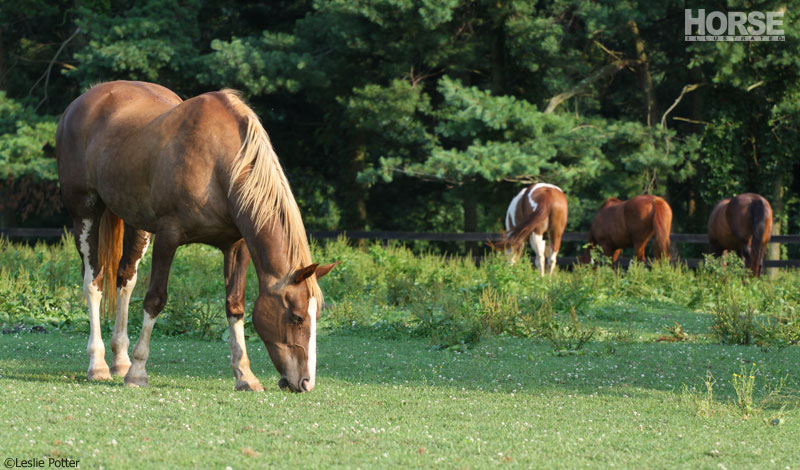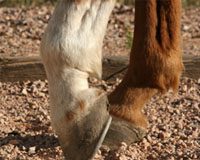In our Ask the Vet column, Dr. Lydia Gray answers your horse-health questions at HorseChannel.com/AskTheVet. Got a question for Dr. Gray? Send it to hc-editor@luminamedia.com and use subject line “Ask the Vet.”
Q: I have five horses, three of which have been treated for ulcers. The symptoms seem worse in the winter. They become more aggressive and act stressed. When they are treated for the ulcers the behaviors disappear. None of my horses are in heavy work. I’ve tried different treatments, but as soon as I stop, the symptoms reappear. My farm is low key and low stress. They have hay in front of them at all times. What else can I do?

A: What a perplexing (and expensive) problem you pose! And it’s not just the expense and effort of treating not one, not two, but THREE horses for ulcers, it’s also the time lost training, competing, or just plain enjoying them, plus the stress of seeing them in pain. Let’s see if we can get you and your horses back on the road to health and happiness.
First, let’s review the risk factors for ulcers. It sounds like you’ve structured your management plan to help reduce your horse’s risk, but there are several proven causes of ulcers, so there may be some other nutritional and management changes you want to consider.
- Diet
- Intermittent feeding
- High grain diet
Too little of the right food or too much of the wrong food are both proven risk factors for gastric ulcers. Because horses are “trickle feeders” designed to eat small amounts of long-stem forage almost constantly, large and infrequent meals–especially ones containing calorie-dense concentrates, like commercial grain–can lead to excess amounts of ulcer-causing acid in the stomach. Make sure your horses have access to grass or hay all the time (have you tried using small hole hay nets with them?) and limit fortified grain by providing a multi-vitamin or ration balancer for basic nutrition and fat for any additional calories needed.
- Limited turnout
- Stall confinement
- Lack of socialization time
Modern horsekeeping is often at odds with how Mother Nature intended horses to live. By keeping them in boxes we not only prevent the constant movement that is so healthy for their hooves, joints, and even digestive system, but we also prevent the social interaction that is so vital to their mind, body, and spirit. The ideal situation would be group turnout 24/7 on high-quality pasture. If that’s not possible, try to allow quality interaction time in a dry lot or paddock so no one is in a stall for more than 12 hours at a stretch.
- Intense exercise
You mentioned that your horses aren’t in heavy work, but everyone’s definition of “heavy work” is different, and since workload can contribute to ulcer risk, I’d like to review the technical definition. According to the NRC (National Research Council’s Nutrient Requirement of Horses), an example of heavy work is 4-5 hours per week spent 20% walking, 50% trotting, 15% cantering, and 15% galloping, jumping, or performing other skill work such as ranching, polo, racing, etc.Here’s a description of changes to the horse’s body because of the heavy work that set it up for gastric ulcers:
- Blood is redistributed away from the abdomen to muscles and skin
- Increased abdominal pressure forces stomach contents into the upper, sensitive area
- Levels of gastrin, a hormone that stimulates secretion of gastric acid, are increased
- There is inhibited esophageal motility and delayed gastric emptying.
Before GastroGard® and the proton-pump inhibitor omeprazole, it was necessary to take horses out of training during treatment, so that these physiologic changes didn’t prevent healing. However, this FDA-approved product for treating ulcers is able to overcome the negative effects of exercise and permit tissue repair. The same is not true for other medications such as cimetidine and ranitidine, so review your prescriptions and protocol with your veterinarian.
- Stress
You mentioned that your farm is low-stress, and while that may be true for the humans, horses face stress in a number of ways. Defined as a “general adaptation syndrome” where the body attempts to maintain homeostasis in the face of environmental challenges, each of the following can be a source of stress for your horse:- Training/Competition
- Transportation
- Schedule changes
- Injury or illness
Ultimately, any of these stressful events can lead to ulcers by stimulating cortisol release, which inhibits the production of factors which protect the mucosal lining of the stomach. Carefully review your program to see if your horses might be silently coping with stress. It might not seem stressful to you, but your horses may be quietly dealing with an issue.
- Excessive use of NSAIDs
Non-steroidal anti-inflammatory drugs such as bute, Banamine, and others lead to ulcers in much the same way as stress, by inhibiting prostaglandins, the factors which protect the mucosal lining of the stomach. When the balance of these mucosal protective factors vs mucosal aggressive factors is disturbed, the result can be decreased blood flow, decreased mucus production, and increased stomach acid secretion. Limit NSAID use to only what is necessary and only under the direction of your veterinarian. If you use multiple veterinarians to care for your horses, make sure that they all know that your horses are struggling with recurring gastric ulcers, so that you can all work together to help keep your horses
Between closely examining what’s different on your farm during the winter and devising a treatment and prevention program with your veterinarian(s) that’s backed by scientific research, hopefully you can get to the bottom of your herd’s crankiness and get back to fun!
Liked this article? Here’s more from Dr. Gray:
Deworming and Ulcers
The Colic/Ulcer Connection







